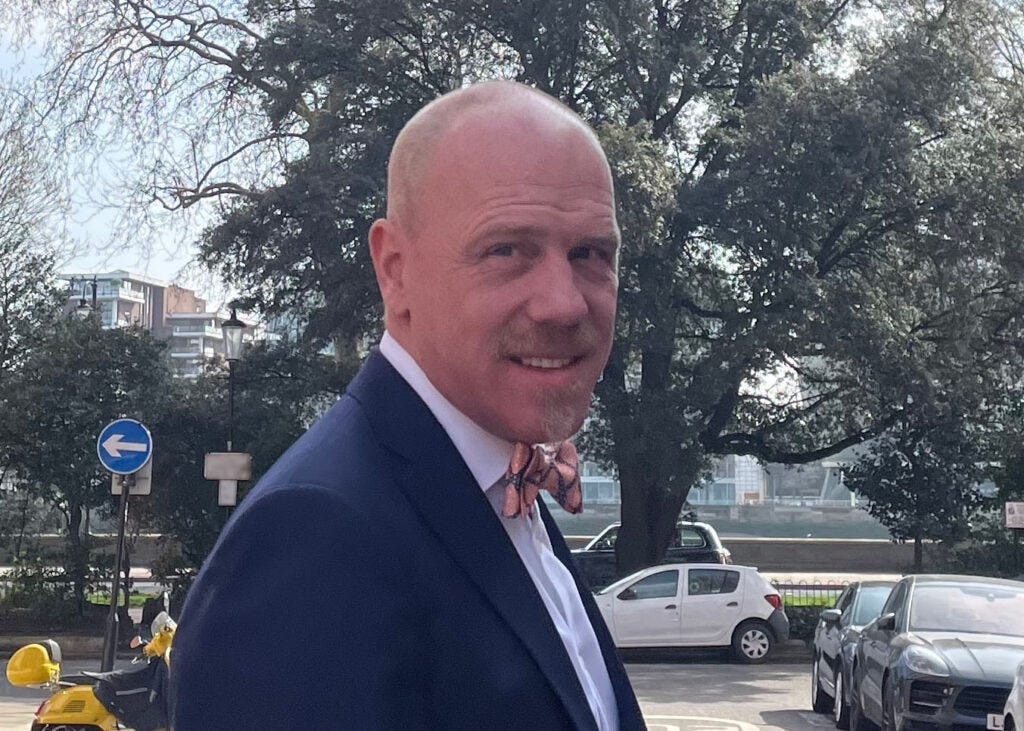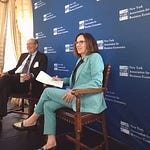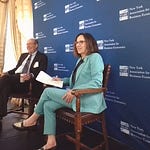Marvin Barth loves themes. For him they are a framework he uses to weave together all kinds of macroeconomic forces, financial market trends, geopoltical tensions and more to analyze what is happening now and forecast what will happen next on all of these fronts. Put this together with his years working as an economist at the Federal Reserve, U.S. Treasury and BIS (Bank for International Settlements), as well as his extensive experience at major banks and financial firms around the world and what do get? His independent strategic insights firm, Thematic Markets.
As for themes, for economists and and investors and businesses one universal theme right now is tariffs and inflation. So in this week where U.S. prices came in higher than expected in June while the following day producer prices were suprisingly tame, puts this all in perspective.
Dive in and hear why Marvin says “menu costs” are currently holding back businesses from passing tariffs on into the prices they charge, something that cannot be counted on to last. And why uncertainty over what is going to happen to tariff policy, and how firms will react to this, make it as hard as it has ever been for him to forecast what comes next.
”I think that’s one of the key things holding back prices right now, which makes it really hard as a forecast to try and figure out where things are going to settle, because the people you’re trying to forecast can’t even figure it out,” Marvin says.
How will the Fed factor all of this into its policy decision in two weeks? Find out why he is about as far away from rate cuts coming any time soon as you can get. Spoiler alert: It has to do with the vaunted neutral rate, R* that the Fed watches in the background is probably higher than policy makers estimate. And the fact that inflation expectations have not yet been tamed.
Producer prices are input prices; they are not showing pressure 00:01:45.930
Producer Prices are input prices. Since a lot of the stuff that we import is frankly inputs into the production function, they are producer prices. So the flat prices today are quite an interesting sign that we're still not getting this big tariff effect coming through… whereas, you know, yesterday's consumer prices. You know, as you know, did bump up, and all of a sudden everybody said, Oh, it must be tariffs, but producer prices seem to suggest no, it really wasn't about tariffs. And I think the the real key thing for everyone to focus on from here is what happens to consumer inflation expectations, because that's the thing that I think is really going to drive the trend far more so than a short term cost shock, even if it does show up in.
US vulnerability is in Servies and agriculture 00:03:39.770
Tariffs should show up in various forms of good prices, primary materials it intermediate or final goods. Right, because all of those things are part of the imported goods spectrum. And remember that while a lot of the retaliatory tariffs on the US are threatened on US services. That’s because that's what the US exports, a lot of services or agricultural products. The tariffs that the Trump Administration has been putting on are almost exclusively all on goods, prices, or on goods. So that's where we should look for it.
Inflation Expectations Key Inflation Driver Now 00:05:05.150
Well, so this is one of the reasons why I focus so much on expectations. Is that you know I think that expectations are really the sort of key driver of inflation at this stage. They're what led to the big inflation in 2021 and 2022. And the Fed hasn't fully contained people's expectations, and that's meant that there's been - if you look back particularly over the last 2 years - there's been this sort of cat and mouse game between producers and consumers, where the producers know that everybody thinks inflation should be higher, so they try and sneak through a price gain whenever they can, and the consumers accept it at first, but then it gets to a point, and they pull back. And so if you look, there's this real seesaw action between real expenditure and prices over the last 2 years.
Inflation Surge Followed Fed’s Fall Rate Cuts as Firms Ancticipated Tariffs
(approx) 00:05:43:21 - 00:06:12:07
And if you go back and look at the beginning of this year, remember, the fed was cutting rates last fall into, and you know I was warning people. They haven't solved the inflation expectations problem yet, and sure enough, we had this huge surge in inflation in January and February. and that was exactly when all these firms were importing all these things. So what you can deduce from that, or at least what I deduced from that is that the firms anticipated that tariffs were coming. That's why they built up inventories, and they raised their prices already. Then consumers balked at it. So we actually had a drop in inflation because the firms backed off for a couple of months in March through May, and what we're starting to see now is the rebound of that, and my expectation is that you will see these expectations. For higher inflation continue to feed through, and that ultimately the firms are going to be pushing through those price hikes to preserve their margins.
Inflation from missing to persisting 00:08:17.318
Marvin Barth: You know I I was one of the first people to highlight very early in the 2010’s what I called missing inflation, the collapse in inflation. I did that well before most other people even noticed it. I was, you know, highlighting that inflation was actually picking up towards the end of the last decade, and then Covid gave it this huge boost. I didn't see that as transitory, and, as I mentioned earlier, as the Fed, and a lot of people in markets have said that inflation was coming back down. I was saying, Yeah, it is, but it's not coming back down to target, and they haven't contained inflation expectations. I've been persistently right on it the last 3 months was the 1st time I've ever seriously in the last 2 2 decades been significantly wrong for an extended period. And so one of my points from that is, I have probably my greatest uncertainty over the inflation outlook. Now, as I've ever had.
Has uncertainty been good for the US? 00:09:39.860
People talk about uncertainty affecting investment in the United States, which actually, I would say, the evidence is quite to the contrary of that it seems like it's actually provoking investment.
Menu Costs explain price-hike reluctance- 00:09:51.780
But where would it? Where does it show up? I think the reason why we haven't seen more of the tariff inflation yet is that firms aren't sure where this is going to settle. And so, you know, there are costly menu costs. So menu costs is a term that economists use to describe effectively the reticence that producers have to change prices that frequently you might think in theory, that you know, firms should just change their price, the second, their input prices go up. But there's a cost to that, like, if you think about a restaurant you're going to have to go reprint your menus every day, and you know nowadays it's not such a big deal. But in the old days it was. It was a big deal. To do that. Now, that's not the real cost change, you know. Adjusting your pricing sheet is not a big cost these days. But what is a big cost is every time you change your price you give your customers a chance to think. Hmm!
The end game for price hikes 00:11:22.260
What is ultimately going to happen with tariff policy, tariffs are going to settle what your cost structure is going to be. You might want to wait until you have better information on that to make that price adjustment rather than adjusting it all along, and I think that's one of the key things holding back prices right now, which makes it really hard as a forecaster to try and figure out where things are going to settle, because the people you're trying to forecast can't even figure it out.
I disagree with the Fed on rates and risks 00:13:27.560
So the 1st thing is… I strongly disagree with them. They think rates are restrictive. They think that R-star, the neutral, real rate of interest that you know, keeps the economy humming along at its potential growth rate is significantly lower than where it is, although they are starting to finally admit that it may not be significantly lower, but they still think it's lower. So all of them have this bias to want to cut. But then they're getting all this pressure from the White House, and so some of them want to make sure that they don't look like they're caving into political pressure. But then there's this other really important thing, which is what we were talking about before, inflation expectations. And, you know, while I've actually focused a lot more on the New York Fed Survey and looking at different demographic groups. And that actually adds a lot of information about really what's driving prices. Of course, the granddaddy survey is the University of Michigan Survey. That's been out since 1978, and that's the one you will hear FOMC members talk about. And we've just had the biggest jump in history in inflation expectations both at the long end, people's long term, inflation, expectations, and their one-year inflation, expectations <in that survey>. So if you are facing this uncertainty, you're also facing all this political pressure, and you don't want to look like you're caving to it, and you just got a very clear signal that consumers may not be trusting you fully. The Central Bank has got to stay on hold. If it doesn't, they are really seriously on the verge of a significant policy error.
R-Star Vs R-asterisk? 00:15:38.710
I've been saying for 2 years. Their credibility is like they keep coming out saying, yeah, neutral is lower, and we should cut rates, and they keep being wrong. Right? I mean to the point. Inflation is still above target and the economy, you know. Yes, we've had some volatility in the last 2 quarters associated with tariffs, but the economy is still growing quite robustly
Not so long and not so variable lags? 00:17:34.960
Everybody loves to talk about long and variable lags. You know the famous Friedman and Schwartz, long and variable lags in monetary policy. but I'm aware of no study out there that has those lags over 18 months right? And yet we had over a 24-month period from you know, late 2022 through late 2024, real front end. Rates one year. Tips rates were on average almost 3%. and we had above trend inflation the whole time. Yes, it did start to come down. We had growth that averaged 2 and a half to 2 and 3 quarters percent over that entire period.: and the peak of fiscal policy was back in the 1st quarter of 2023. you know, by the time they started cutting radically. You had had the economy growing almost a full percentage point over what they themselves is potential. And they had held real rates at a level 2 to 2 and a half percentage points above what they said is neutral. So clearly they were wrong
Productivity optimism! 00:25:15.970
One of the things I think might be a big surprise to people is that tariffs in this unique circumstance. And that's an important point. It is a unique circumstance might actually lead to a big productivity boom in the manufacturing sector. So I'll leave you with that controversial thought.
Marvin Barth is the creator of Thematic Markets and Seriously, Marvin?! Thematic Markets is rigorous, institutional-quality research aimed at market professionals, while Seriously, Marvin?! presents more accessible takes on contrarian musings Marvin doesn’t have time to research at Thematic Markets. Both publications benefit from the uniquely broad perspective on the global political economy Marvin has gained from a three-decade career spanning nearly every asset class, academia, central banking, finance ministry, and international institutions.
Trained in Economics (B.A., M.A. and Ph.D.), Marvin has worked as an economist, strategist and portfolio manager at major global banks, asset managers, and across the policy spectrum, including the Federal Reserve Board, the U.S. Treasury Department, and the Bank for International Settlements.
Raised in California, Marvin lives in London.
*****************************************
Note: Marvin’s path to founding Thematic Markets includes working his way through graduate school as a commercial salmon fisherman. Read his much longer and very interesting bio here:
https://thematicmarkets.com/bio-3/













Share this post